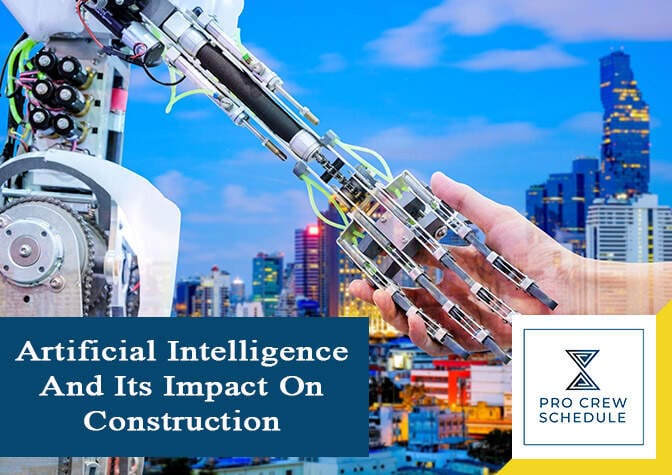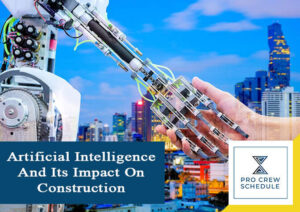Construction has come along from being a highly non-digitalized industry. Project managers used to only reply on pen and paper when managing construction projects. Today, there is an abundance of project management software to help them in keeping the crew and project in line. On the same note, the workers have also greatly benefited from technology. Advanced machinery and equipment have improved productivity and safety.
But the advancement of the construction industry is just getting started. With the emergence and development of AI, countless innovations have come about that have impacted the field.
What is Artificial Intelligence (AI)?
The words “AI” and artificial intelligence have been thrown out a lot in these recent years. However, most people don’t have a clear understanding of it.
AI is an interdisciplinary science that has multiple approaches. It’s a broad branch of computer science that deals with designing and creating smart systems capable of behaviors associated with human intelligence, such as problem-solving, pattern recognition, and learning.
Today, AI is practically everywhere: it’s used to understand commands to virtual assistants like Siri and Alexa, recognize what are in photos, detect credit fraud, and now shape the construction industry.
AI’s Impact on Construction
1.Project planning and management
In 2018, an AI startup launched and claimed that its AI and robots could solve major construction project problems, namely delays and being over budget. Robots will autonomously take 3D scans of project sites and feed the data to a deep neural network. The network will then determine the progress of the different sub-projects. If it spots some issues, management can look into it and handle it before it becomes a bigger problem.
Future algorithms will use “reinforcement learning,” an AI technique that teaches algorithms through trial and error. It continuously assesses patterns, alternatives, and combinations based on similar projects. Because it continually improves itself and works on the best path, it can help in project planning.
2. Preventing cost overruns
Most large scale general contracting projects tend to go over budget, which is understandable– it can be challenging to focus on finances when project managers have to oversee everything and everyone. But they can now stay on top of handling the budget with artificial neural networks.
Based on a few factors like project size, the project manager’s competence level, and contract type, these networks can predict cost overruns. Predictive also use historical data, such as target start and end dates, to create realistic timelines for future projects.
In addition to that, the crew members also benefit from AI by remotely accessing realistic material for training to add to their knowledge and sharpen their skills. This positively affects project delivery as it cuts the time used to onboard new resources.
3. Generative design
One of AI’s most outstanding contributions to construction is generative design, as it can explore, analyze, and evaluate many different model variations to figure out the best one. This method has already been used in manufacturing, but it is currently being integrated into construction.
Generative design is specifically useful to designers using BIM technology. With AI, designers would explore thousands of major and minor design modifications to create a more stable and safer design, which could even be less costly and quicker to build. AI would cut this process down into mere hours, whereas humans doing this would take months.
4. Land survey and mapping
Mapping and surveying lands are a taxing and time-consuming task. But with drones, Geospatial AI (GeoAI), and Geospatial Information Systems (GIS), time doing these can be significantly reduced and will produce accurate survey maps and aerial images of the site.
5. Improved onsite safety
Construction is one of the most dangerous industries to build a career in. Workers are always at risk for accidents such as falling, electrocution, mishandling equipment, and also body stress injuries.
The responsibility of overseeing safety onsite falls on general contractors and project managers. AI and machine learning tools can help them with this job. With those, general contractors can evaluate subcontractors based on a risk score. They can also prioritize urgent issues so the project manager can work with high-risk teams to solve and reduce any problems.
More than that, the Internet of Things (IoT) is making project sites safer with automation. Management can literally keep track of workers with wearable sensors to determine their location and send alerts if they are in danger or have an accident.
5. Risk reduction
Clients want a high quality of assurance that the project lifecycle would last a long time. But safety is not the only thing at risk on construction sites; there are also cost, time, and quality risk.
So, general contractors can use AI and machine learning solutions to monitor risks and prioritize those so that the project team can direct their limited time and resources on the most serious risk factors, which AI automatically sets as a priority.
6. Increased productivity onsite (robots) (vehicles)
Improved onsite productivity is the most significant benefit construction gets from AI. With automated machinery performing repetitive tasks, such as wall building, concrete pouring, and welding, construction will be more efficient than if humans were to do all those things. Most of the work humans have to do is to program the system and maybe finishing and polishing work at the end. This significantly cuts down the overall time to complete a project and dramatically increases productivity.
Moreover, project managers can keep track of the entire project and its progress in real-time. Through AI, they can use technologies, like onsite cameras and facial recognition, to supervise and assess worker productivity and properly follow procedures.
7. Answer labor shortage
Labor shortage is arguably the largest problem the construction industry is facing today– senior employees are retiring, but there is virtually no youth willing to take a career path in construction to replace them.
This situation is urging construction firms to turn to and invest in data science and AI. In fact, construction firms could boost productivity by 50% by analyzing data in real-time, as a 2017 McKinsey report says.
Today, many construction companies are beginning to integrate AI and machine learning for better distribution of machinery and labor across jobs. They achieve this with a robot that continually evaluates job progress, along with the workers’ and equipment’s location to tell instantly project managers which project sites have enough equipment and workers to finish the project on time successfully, and which ones might be falling behind and need more support.
6 Tech Startups Moving The Construction Industry With AI
AI is quickly becoming the “big thing” in construction. These six startup companies are reshaping the industry with AI-based technology.
1.Built Robotics
BuiltRobotics is perhaps the leading robotics company in construction. Their most significant contribution is an automation technology that makes construction faster, safer, and significantly more productive. Besides having their own line of self-driving construction vehicles, BuiltRobotics offers robotic upgrade kits for construction machinery to operate autonomously. They do this with equipment and sensors that can be bought off-the-shelf and also write software. As of today, their technology supports excavators, dozers, and skid steers, but have more equipment coming out.
2. INTSITE
A combination of aerospace algorithms, Deep Learning, Computer Vision, and off-the-shelf hardware, like cameras and sensors, INSITES’s technology can efficiently turn any heavy equipment into smart, autonomous machines. Because these new and improved machines estimate its posture and visual perception, construction sites now have enhanced safety and performance.
3. Kwant.ai
Formerly onTarget, Kwant.ai aids in increasing productivity and improving safety with AI-powered sensors and predictive analytics. These can be installed within minutes, is worth mentioning.
Using AI, the company analyzes thousands and thousands of project schedules. Their algorithms turn unstructured data into standardized buckets by comparing real-time data from sensors and APIs to standardized forensic data. With that, it can accurately predict if the project’s execution with early warning signs.
4. Versatile Natures
Versatile Natures can turn any project site into a smart field that collects data and gives a detailed analysis of the project’s status with their AI and IoT platforms. These platforms allow managers and contractors to make more informed and timely decisions. In turn, completion is accelerated, profits are increased, and safety is improved.
5. Open Space
Similar to Google Streetview, OpenSpace is a documentation tool for photos and videos. Their proprietary platform, Vision Engine, lets the user capture 360-degree images and videos with zero manual input– the user needs only to wear the Garmin VIRB 360 hardhat camera and walk around the site. Photos, which are taken every half-second, are automatically integrated into project plans. Using OpenSpace can significantly reduce inspection time and locate any safety issues for them to be addressed right away.
6. Dusty Robotics
Dusty Robotics helps contractors and managers with the construction site layout by automating the mobile robot’s process. The robot goes around the project site and marking the layout. If project managers employ Dusty Robotics, they can rest assured that their project’s quality is top-notch as the robot provides consistent and reliable results, ensuring that the workers are working with the latest construction documents.







